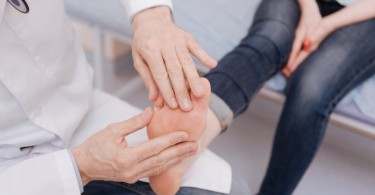Although the name sounds like a simple bruise, a bone contusion is much more painful and lasts longer than a huge swelling of a skin or muscle bruise. 
Advertisements

How to diagnose bone contusion? The most common method of diagnosing bone contusion is magnetic resonance imaging. This imaging method allows you to assess the extent of damage to the bones and affected layers.
In addition, it allows your doctor to see bleeding and swelling that can occur in the area. Although X-rays are helpful in excluding fractures, they are useless in finding bone contusions (see Section 1 of Reference 3). bone contusion vs. muscle or Skin Contusion it is difficult to distinguish common contusion from deep bone contusion on muscle or skin. Usually, the symptoms of bone contusion last much longer on the skin or muscles as a result of more severe trauma or injury.
In addition, bone contusion usually leads to severe swelling, which leads to stiffness of adjacent joints. On the contrary, bruises on muscles or skin heal faster and usually do not have a significant impact on your mobility. Comparison of bone contusion and fracture Because both bone contusion and fracture may be caused by similar trauma, it is important to know which one you are dealing with. Fracture pain is more intense in nature, and bone contusion may cause deeper and more painful pain.
In addition, fractures may be accompanied by skin instability or even abnormal sensation, which is usually not accompanied by bruises. Because these two serious cases are usually confused, if you encounter any of the above symptoms, you must see a doctor, so that you can get the correct diagnosis and treatment. bone contusion treatment immediately after injury, ice pack was applied on the site to alleviate pain and swelling. Ice bags can be applied on wet towels for 10 to 15 minutes every 3 to 4 hours. Ice cubes are usually used for 2 to 3 days after injury or before swelling subsides. Thereafter, heat can be used to reduce pain and promote healing. Usually heated for 15 to 20 minutes, three to four days at a time. Place a towel between the skin and the heat source (hot bag or hot water bottle) to reduce the risk of burns.
Advertisements
Other important treatments are to rest and elevate the injured area as much as possible, and to take over-the-counter anti-inflammatory and analgesic drugs, such as Advil (motrin) or aleve. Rest can create new bone tissue in the body without putting pressure on the injured area.
Depending on the severity of the illness, patients can continue to use splints, elastic bandages or exercise belts for mild activity, while patients with severe illness may need to use crutches or slings to prevent any further injury and allow rehabilitation.
When should I see a doctor for a bone contusion?
Patients who feel severe pain due to bone contusion should contact a doctor immediately after injury to determine whether there is a fracture and make a diagnosis by X-ray.
Some researchers associate bone contusion with other more serious diseases (such as anterior cruciate ligament injury and arthritis). Therefore, if you have moderate pain, but you also have one of the following symptoms, you should see a doctor immediately:
- After 3 or 4 days of ice compress, rest and anti-inflammatory and analgesic drugs, you can not see good results. Conversion or swelling aggravation.
- If you feel pain when you stretch or load.
- If the skin is pale and cool after injury.
Bone contusion may be a precursor to greater problems, such as the development of smooth articular cartilage injury covering the end of the bone. In addition, this type of injury can accelerate the formation of osteoarthritis in the affected area. Therefore, it is important to take this injury seriously and address any symptoms with your doctor in order to reduce the chances of these potential side effects.





Comments